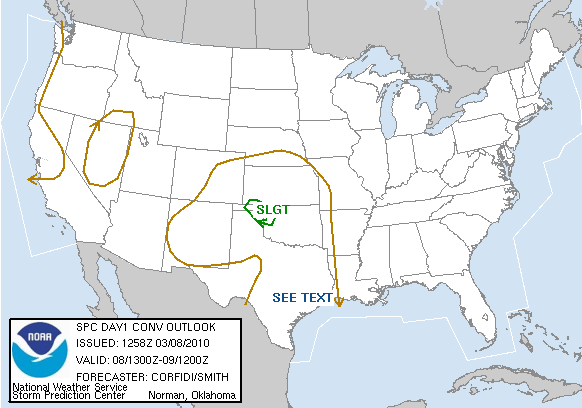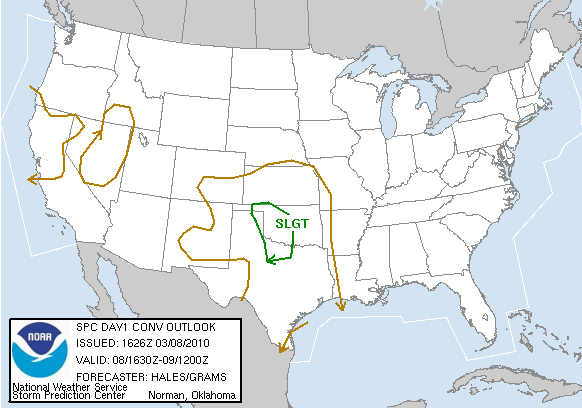Thursday, April 22, 2010 Severe Weather Forecast
There are three things I analyze (as do most meteorologists) when forecasting the severe weather potential for an area: instability, moisture, and wind shear. Here are a few, basic definitions of each of these:
Instability: the tendency for an air parcel (blob of air) to move, in this case rise. Warm air will rise when it is in air cooler (i.e. less dense) than it is. The colder the air of the environment is compared to the parcel, the more easily the parcel can rise. This is necessary for updrafts to develop in thunderstorms.
Moisture: fairly obvious, but the amount of water in the atmosphere. This is necessary to produce condensation and precipitation within thunderstorms.
Wind shear: change in wind speed and/or direction with height or distance. In the case of severe thunderstorms, we need changing wind direction with height. This allows for rotation to develop. If you want to visualize this, take a pencil and hold it horizontally between your hands. Move one hand toward you and the other away from you and you will notice that the pencil will rotate. This is the basic concept of wind shear (we won't get into any differential equations!).
When examining instability, there are two major parameters to look at: convective available potential energy (CAPE) and convective inhibition (CIN or CINH). CAPE is the amount of energy available in the air to produce updrafts. The vertical velocity of updrafts is determined by this energy (again, we won't get into the physics here, but if you want to, let me know via comments). CINH is the amount of energy required to start the process of lifting parcels and is produced by air aloft that is warmer than the parcels we are trying to raise. This cap can be eliminated by dynamic forcing (forces the parcels above the cap) from cold fronts, dry line, and other things.
Here is the forecast CAPE from the GFS and NAM forecast models for 7:00 pm CDT April 22:
 The GFS model places a bulls eye of 2000+ J/kg (energy per mass) over southwester Oklahoma in the vicinity of Altus while the NAM has two areas of 2500+ J/kg over western Texas, one southwest of Childress and another northeast of Del Rio. This is plenty enough instability to sustain updrafts, but can they form.
The GFS model places a bulls eye of 2000+ J/kg (energy per mass) over southwester Oklahoma in the vicinity of Altus while the NAM has two areas of 2500+ J/kg over western Texas, one southwest of Childress and another northeast of Del Rio. This is plenty enough instability to sustain updrafts, but can they form.Below is the model forecast CINH for 7:00 pm CDT April 22:

Both models show CINH of less than 25 J/kg over the same areas the models forecast the strongest CAPE. This means it won't take much energy to get updrafts started. The combination of daylight heating and dynamic forcing should be enough to allow rising air to break the cap. Thunderstorm development should not be a problem.
Looking at moisture, dew points will be well into the 60s over the region of greatest instability. 60s are generally good enough for strong convection to development, though upper 60s and into the 70s are generally better (you can't really have dew point too high, especially in this week's set up). In the graphic below (GFS Forecast Dewpoints for 7:00 pm CDT 4/22), we can clearly see a dry line over the high plains of the Oklahoma and Texas Panhandle. This is the boundary we will be watching for thunderstorm development on Thursday. Note the southeasterly winds over northwestern Texas and down the dry line, this will be important later when we talk about wind shear.

Looking at moisture, dew points will be well into the 60s over the region of greatest instability. 60s are generally good enough for strong convection to development, though upper 60s and into the 70s are generally better (you can't really have dew point too high, especially in this week's set up). In the graphic below (GFS Forecast Dewpoints for 7:00 pm CDT 4/22), we can clearly see a dry line over the high plains of the Oklahoma and Texas Panhandle. This is the boundary we will be watching for thunderstorm development on Thursday. Note the southeasterly winds over northwestern Texas and down the dry line, this will be important later when we talk about wind shear.

In addition to surface dew point, we must look at what is known as the "lifted condensation level", or LCL for short. In basic terms, the LCL is the height at which a lifted parcel becomes saturated (its relative humidity reaches 100%) due to cooling with height. In general, this is where we find the cloud bases. If this is too high, it will be difficult for tornadoes or supercell structures to develop. Looking at the LCL forecast for Thursday evening, the LCLs look to be low enough to support low-level cloud formation across southwestern Oklahoma to around the Childress area, but the rise in LCLs over western Texas and farther south will make this low-level cloud formation difficult.


Lastly, we look at wind shear. There are two types of wind shear we must look at: deep layer and low-level. Deep layer wind shear is required for rotating supercells to develop. Low-level wind shear is what's required for tornadic development. Another parameters that we can examine is called helicity. Helicity is the tendency for air to rotate. The graphic below is the forecast helicity for Thursday evening.


The NAM is forecasting helicity of over 400 in a small area near Childress on Thursday evening with regional helicity values at or above 200. This means that wind shear will be high enough to support the possibility of supercell development and just maybe, a tornado or two.
Putting this all together, we will now examine the forecast soundings for Childress, Texas, the area that appears to be the target for severe weather at this time.

Putting this all together, we will now examine the forecast soundings for Childress, Texas, the area that appears to be the target for severe weather at this time.

The sounding on the right (NAM) paints a much more ominous picture than the one on the left does. The green line on the left indicates dew point and the red line indicates temperature. The flags on the right side of each chart indicate the direction that the wind is blowing FROM and the speed (long lines mean 10 knots, short lines mean 5 knots, and triangles mean 50 knots). The winds on the NAM graphic show intense low-level shear while the GFS seems to be showing much weaker shear. This shows that both models still have fairly strong disagreements. If the NAM were to play out, the probability of severe weather, and tornadoes, would likely be much higher than if the GFS were to plan out. So here is the bottom line:
Probability of thunderstorms: high (70%)
Probability of severe thunderstorms: moderate (50%)
Probability of one or more tornadoes: moderate (40%)
Probability of one or more strong tornadoes: low (10%)
Area to most likely experience severe weather: southwest Oklahoma/northwest Texas
Timing: late Thursday afternoon and early evening
I will probably put out a "follow up" blog should things significantly change regarding this event. Remember that these are the thoughts of an amateur. Listen to products from the National Weather Service for decisions regarding the protection of life property.
Probability of thunderstorms: high (70%)
Probability of severe thunderstorms: moderate (50%)
Probability of one or more tornadoes: moderate (40%)
Probability of one or more strong tornadoes: low (10%)
Area to most likely experience severe weather: southwest Oklahoma/northwest Texas
Timing: late Thursday afternoon and early evening
I will probably put out a "follow up" blog should things significantly change regarding this event. Remember that these are the thoughts of an amateur. Listen to products from the National Weather Service for decisions regarding the protection of life property.













